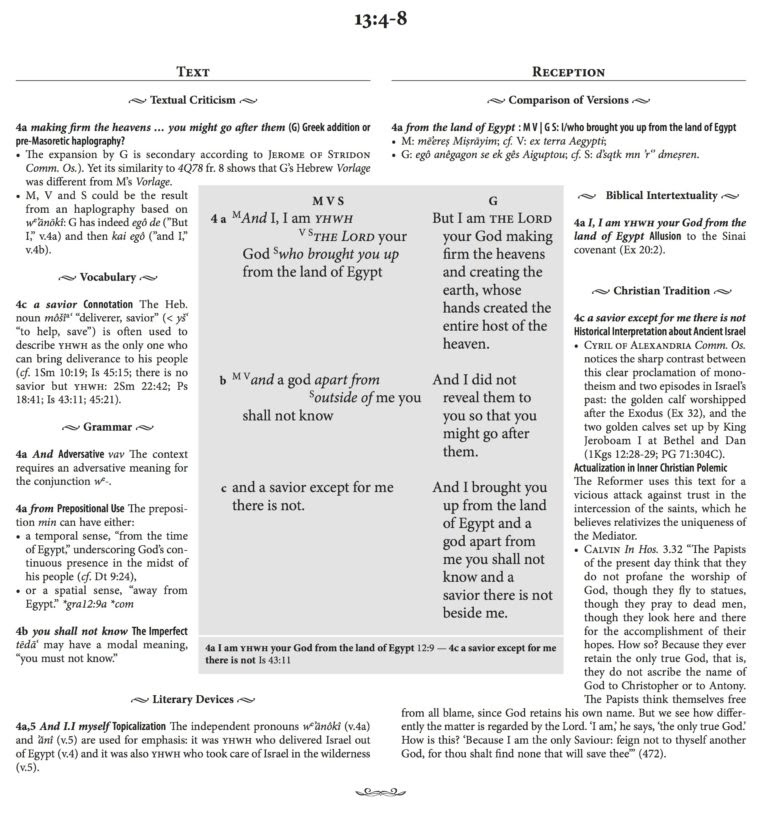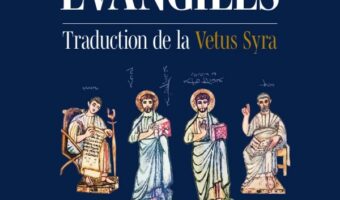
« Les Quatre Évangiles | Traduction de la Vetus syra », lancés au Collège des Bernardins le 14 novembre dernier
15 novembre 2024
lancement de l'évangéliaire vieux-syriaque au collège des Bernardins
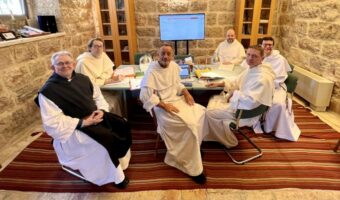
1. Le Comité éditorial et ses membres
19 novembre 2025
Le Comité éditorial de La Bible en ses Traditions a retrouvé son rythme hebdomadaire. Chaque vendredi, les discussions reprennent : affiner les choix de traduction, préciser les principes éditoriaux, suivre l’avancée des volumes et des collaborations. À ces tâches s’ajoutent les décisions stratégiques pour les nouvelles orientations et le développement numérique dans une dynamique à […]
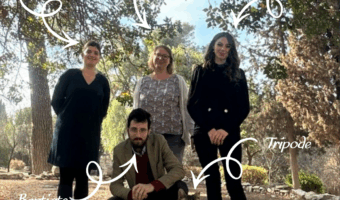
2. Dans le « bureau d’en face »
19 novembre 2025
Au cœur du chantier scientifique de La Bible en ses Traditions, sœur Marie-Reine, que vous connaissez bien, a accueilli les assistants dans son bureau. Elle y poursuit la rédaction de notes — surtout archéologiques, ces derniers temps. Autour d’elle, chacun apporte ses compétences et, en mettant du cœur à l’ouvrage, contribue à la recherche, à […]
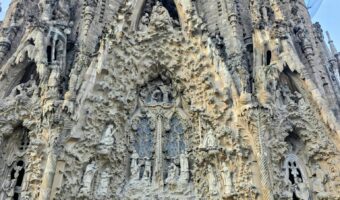
3. Chez nos collaborateurs
19 novembre 2025
Derrière le vaste chantier de La Bible en ses Traditions se tient une équipe de collaborateurs passionnés : chercheurs, enseignants, éditeurs, spécialistes du texte et de ses traditions. Notre cathédrale biblique nécessite un travail collectif où se mêlent exégèse, analyse philologique, interprétation historique, connaissance des traditions juives et chrétiennes ou encore de l’histoire des arts. […]
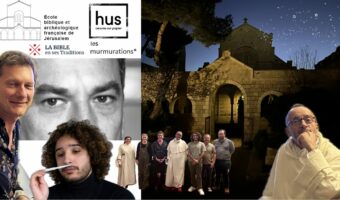
4. Chez nos amis artistes, quand s’unissent l’art et la science
19 novembre 2025
Le parfum du Cantique des cantiques arrive pour Noël ! L’aventure de notre édition botanique du Cantique des cantiques, réalisée par Olivier-Thomas Venard et sœur Marie-Reine Fournier, continue. Grâce au partenariat avec Laurent Derobert et les artistes de la Galerie Hus à Paris, ainsi que les éditions des Murmurations, le projet qui avait retenu l’attention […]

5. Bienvenue aux journalistes !
19 novembre 2025
Le projet La Bible en ses Traditions suscite des échos dans les médias, qui participent au rayonnement de nos travaux savants au-delà des milieux académiques. Depuis la rentrée, parmi nos visiteurs journalistes, tous plus sympathiques les uns que les autres, nous avons reçu : Cette présence médiatique accrue se déploie également sur les réseaux sociaux, […]
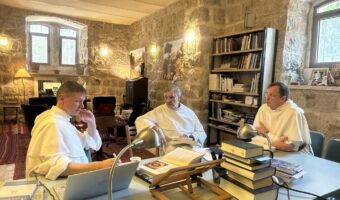
Visite de travail des frères Pablo Sicouly, o.p., et Pavel Syssoyev, o.p.
17 novembre 2025
Le frère Pablo Sicouly, o.p., vicaire du Maître de l’Ordre et socius pour la vie intellectuelle, et le frère Pavel Syssoyev, o.p., socius pour l’Europe, se sont rendus au couvent Saint-Étienne pour une visite fraternelle. Il s’agissait de la première visite officielle du frère Pavel à Jérusalem dans cette nouvelle fonction. Cette rencontre a permis […]

Avis au collaborateurs théologiens : Le « Denzinger » est bien vivant !
23 octobre 2025
La rubrique « Théologie » dans l’annotation de La Bible en ses Traditions se concentre sur les usages de l’Écriture dans le Magistère et chez les « grands théologiens ». La vigilance de frère Marc Leroy, notre secrétaire-archiviste, porte à notre attention la nouvelle suivante, qui la concerne directement : Michael Seewald a succédé à […]

Un regard sur nos activités – Photos de Kobi Wolf
20 octobre 2025
Lors de son passage chez nous, dans le cadre d’un reportage réalisé pour Famille Chrétienne, le photographe Kobi Wolf a su capter des instants simples et précieux de nos activités et de notre quotidien. Certaines de ses photos sont visibles sur son compte Instagram @kobiwolf. Voir cette publication sur Instagram Une publication partagée par Kobi […]

Bâtisseur de cathédrale biblique : Frère Olivier Catel, o.p.
17 octobre 2025
Au cœur de la construction de notre cathédrale biblique, il y a des artisans passionnés… Voir cette publication sur Instagram Une publication partagée par La Bible en ses traditions (@la_bible_en_ses_traditions) Frère Olivier Catel o.p. , membre du comité éditorial BibleArt, pour moi …Après des années de travail au comité de La Bible en ses traditions, […]
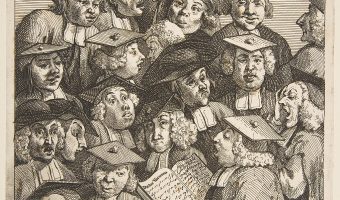
Les projets partenaires
7 octobre 2025
Du côté de Biblindex Le séminaire reprend Alice Leflaëc et Laurence Mellerin communiquent : la première séance de séminaire à proprement parler aura lieu le 31 octobre. Les séances ont lieu en bimodal, en présentiel au 22 rue Sala et en visio via ce lien : https://cnrs.zoom.us/j/99701628112?pwd=NUZxaSt3Z29MU2t2YWtNdVM3L0krZz09 En voici le programme préliminaire : Contacts : alice.leflaec@orange.fr / laurence.mellerin@mom.fr Le […]
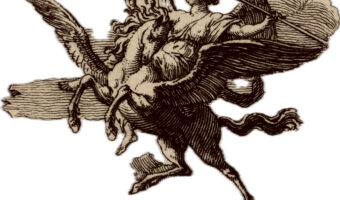
Nos collaborateurs publient
6 octobre 2025
Universitaires ou artistes, ils nous partagent leurs dernières trouvailles. Les philologues : en direct des études perses appliquées à la Bible Dr Gad Barnea est prolifique en articles savants, publiés dans les meilleures revues et disponibles en open access. MERCI à lui de nous les faire connaître et pour mémoire, ses autres publications en cours […]
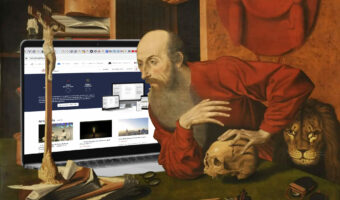
1. La vendange de l’année
30 août 2025
Cette année encore, notre plateforme s’est enrichie de manière spectaculaire, portée par le travail patient et collectif de nos contributeurs. Publications numériques Plusieurs centaines de nouvelles notes multimédias ont été créées : critique textuelle, arts contemporains, musique, histoire de l’art… Nous avons dépassé les 5 000 notes multimédia en ligne, sans compter les dizaines de […]
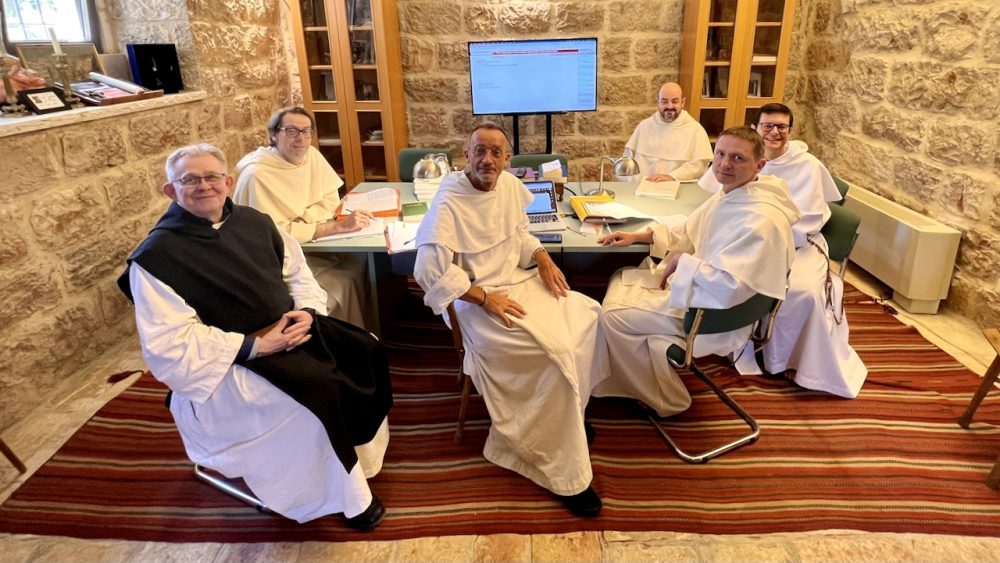
2. Les ouvriers à la Vigne
30 août 2025
Frères et sœurs dominicains, ou membres d’autres ordres, chercheurs, assistants, universitaires et experts internationaux ont continué à œuvrer ensemble, semaine après semaine, dans l’ombre comme dans la lumière, pour bâtir notre Bible annotée fidèle à ses traditions et ouverte aux cultures. Le comité éditorial Issu du Conseil académique de l’EBAF, le comité dirigé par fr. […]
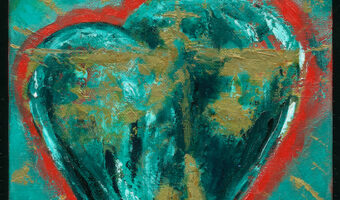
3. Renforts et ornements
30 août 2025
Aux vignerons individuels que sont nos collaboratrices et nos collaborateurs se joignent des programmes ou des institutions amies, pour nous aider à construire notre cathédrale biblique Partenariats scientifiques Barbara Cassin, de l’Académie française, a relancé notre collaboration au sein de son programme « Les intraduisibles des trois monothéismes ». Déjà associé à ce programme à ses débuts, […]

4. Développement numérique
30 août 2025
Le déploiement numérique du programme s’est poursuivi cette année avec rigueur et ambition. La réussite majeure de l’année Ce fut la mise en production complète de notre plateforme collaborative scribe.bibletraditions.org, désormais pleinement opérationnelle en mode « live » : chaque élément validé y est automatiquement synchronisé avec les différentes interfaces de lecture (scroll, portail, BibleArt), garantissant une […]

Forte présence médiatique à l’occasion du témoignage de notre directeur
30 août 2025
Ce printemps 2025, plusieurs médias ont voulu faire écho au témoignage sur la vie du cœur et de l’intelligence en Terre sainte aujourd’hui, commandé par les éditions Grasset à Olivier-Thomas Venard, et mis au jour le 2 avril. Nos interfaces de consultation ont alors connu de petits pics de fréquentation… Merci aux amis journalistes de […]
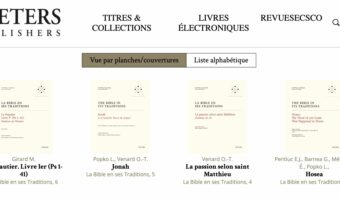
Deux nouveaux volumes dans notre collection chez Peeters !
25 juillet 2025
Tout récemment est sorti, avec le sous-titre de Bonheur de l’homme, le livre 1 du Psautier monumental que notre ami le professeur Marc Girard est en train de préparer, depuis de longues années, pour La Bible en ses Traditions. Fruit de toute une vie de recherche de la science et de la sagesse, ce psautier […]
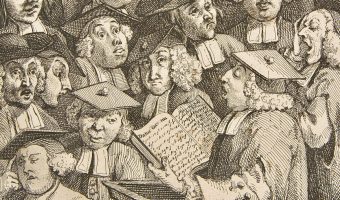
D’anciens étudiants de l’École biblique publient
9 juin 2025
Pierre de Curraize : « Jérémie, un paradigme pour Paul ? » Il y a … dix ans, Pierre suivait notre séminaire conjoint avec Serge Ruzer à l’Université hébraïque. Il a récemment publié sa thèse : Jérémie, un paradigme pour Paul ? Étude de l’emploi de textes jérémiens dans la rhétorique de quelques péricopes des […]
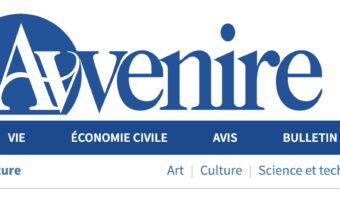
Un article de frère Łukasz Popko sur BibleArt dans l’Avvenire
7 juin 2025
Le 7 février 2025, à l’occasion de la sortie de son livre avec Fr Timothy Raddcliffe, le frère directeur de notre comité éditorial a présenté avec brio l’essentiel de notre projet dans le grand journal italien :
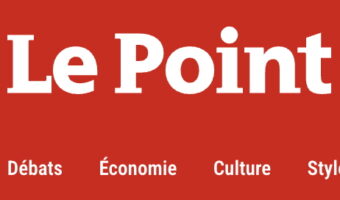
Un article enthousiaste du Point sur BibleArt
7 juin 2025
Merci à Jérôme Cordelier pour ce bel article

Rendez-vous « évangélique » à Luxembourg les 13-14 mars
2 mars 2025
Dans le cadre des festivités liées au septième centenaire du Docteur angélique, et d’une visite des reliques du saint dans le Grand-Duché, nous coorganisons avec la Luxembourg School of Religion and Society deux journées de colloque sur Thomas d’Aquin comme figure de renouveau évangélique. Après le colloque de Barcelone l’an passé, ce sera une occasion […]
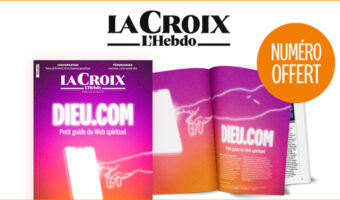
BibleArt citée parmi les « must » du Carême
1 mars 2025
Merci aux amis de La Croix de faire connaître votre appli biblique préférée, (ainsi que notre petite-fillote devenue grande Prixm) tout est dit dans leur dernière phrase pour présenter BibleArt : « Une gigantesque cathédrale de pixels dans laquelle on n’a qu’une envie : se perdre »* *cf. Matthieu 16,25 Dieu.com : numéro offert ! À l’orée du […]
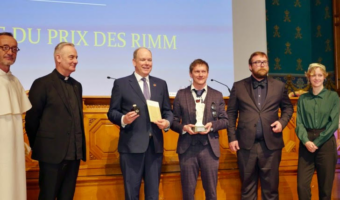
Une aide de la Principauté de Monaco
12 février 2025
Nous sommes heureux de remercier ici la Direction des Affaires Culturelles du Gouvernement princier, à travers la Société pour la Gestion des Droits d’Auteurs (SOGEDA), pour son soutien à notre entreprise d’édition botanique des Écritures. En 2025, elle contribue ainsi au financement de la recherche biblico-botanique et de la création artistique de notre Sœur Marie-Reine […]

Appel à candidatures : AMI en Philologie (Grammaire, Lettres classiques, Études sémitiques) pour 2025-2026
28 janvier 2025
Aide à la Mobilité Internationale en Lettres à Jérusalem — Scholarship in Jerusalem
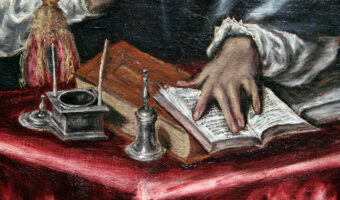
Appel à candidatures : AMI en Littérature (française | francophone) pour 2025-2026
28 janvier 2025
Aide à la Mobilité Internationale en Lettres à Jérusalem — Scholarship in Jerusalem

Appel à candidatures : AMI en Histoire de l’art, pour 2025-2026
28 janvier 2025
Aide à la Mobilité Internationale en histoire de l'art à Jérusalem — scholarship in art history in Jerusalem
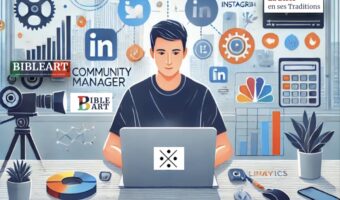
Appel à candidatures : Community Manager pour 2025-2026
28 janvier 2025
Aide à la Mobilité Internationale en Lettres à Jérusalem — Scholarship in Jerusalem : Community Manager

Action de grâce pour la vie du bureau à Jérusalem
4 janvier 2025
nouvelles des activités de la BEST à l'automne hiver 2024

Des messagers de bonnes nouvelles nous rendent visite
28 décembre 2024
soutiens à la Bible en ses traditions en visite à Jérusalem
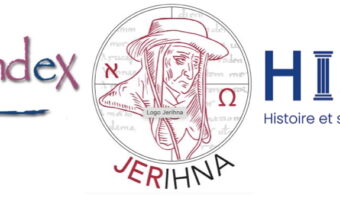
Collaborations scientifiques
28 décembre 2024
Nouvelles collaborations scientifiques inter-institutionnelles entre La Bible en ses Traditions et d'autres programmes de recherche
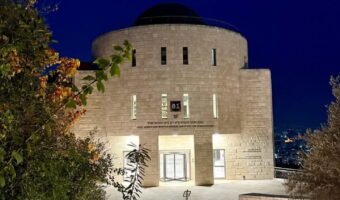
Lancement du « Jerusalem Consortium for New Testament Studies »
21 décembre 2024
Le 3 décembre au soir, une assemblée fournie d’environ 80 personnes se pressait dans une belle salle du bâtiment Mandel, à l’université hébraïque de Jérusalem, pour participer au lancement du « Jerusalem Consortium for New Testament Studies ». En ces temps de violences multi-azimut en Terre sainte, comment ne pas se réjouir que des bonnes […]
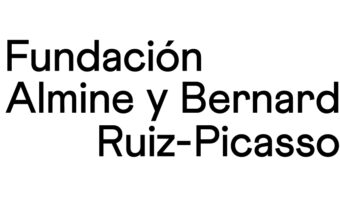
Picasso : racines bibliques
25 novembre 2024
Favorisée par le P. Christian Venard, une rencontre entre fr. Olivier-Thomas, directeur de notre programme et Monsieur Bernard Ruiz-Picasso a permis de poser les fondations d’une collaboration entre la Bible en ses Traditions / BibleArt et la Fondation Almine & Bernard Ruiz-Picasso. En effet, le petit-fils de Pablo organise pour l’automne prochain ou le printemps […]
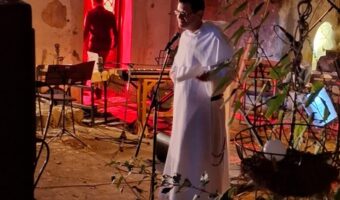
Bible, théologie & culture : « Les 7 péchés capitaux »
9 novembre 2024
Fr. Olivier Catel, de notre Comité éditorial, au festival d’Ein Kerem Le mercredi 23 octobre, le frère Olivier Catel est intervenu lors du Festival d’Ein Kerem à Jérusalem. Étienne Lepicard, directeur de « Beth Ha-Gat », et l’association MAROM, qui a pour mission le dialogue judéo-chrétien en Israël, ont organisé une représentation des Sept péchés capitaux, […]
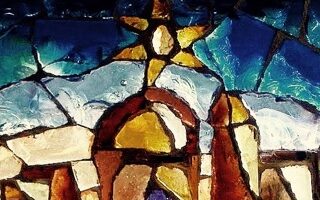
Reconnaissance et espérance
2 août 2024
Reconnaissance MERCI à vous, d’abord, pour votre soutien qui a permis, enfin, le « lancement » de nos nouvelles interfaces BibleArt, pour consulter notre base de données depuis vos mobiles ou vos ordinateurs fixes (et bravo à nos développeurs numériques !) : MERCI à ceux qui nous ont quittés ces derniers mois, pour tout ce […]
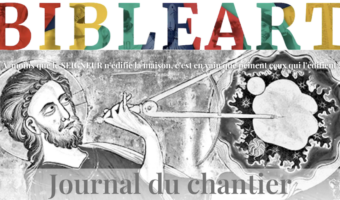
« Journal de chantier » : des nouvelles mensuelles
2 août 2024
En plus de la présente lettre bisannuelle d’informations sur le développement général de La Bible en ses Traditions, pour accompagner le lancement de BibleArt, nous enverrons une fois par mois des nouvelles concernant les enrichissements et améliorations de notre bible en ligne, en dialogue constant avec ses utilisateurs, sous forme d’un « journal de chantier […]
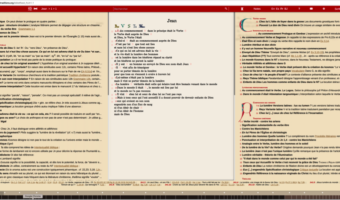
A Digital Scroll: Why?
6 juin 2014
Altering the ‘Default Setting’ of Printed Bibles… We offer to the general public access to a new way of editing and translating the Bible: the scroll of the ‘BIBLE IN ITS TRADITIONS’ (in French, with insights in English and Spanish). This free new edition is the basis of an ongoing work of numerous teams which […]

BIBLE EN SES TRADITIONS AISBL : nous avons une personnalité juridique !
6 août 2015
Maintenant que notre programme de recherches commence à prendre son essor, et alors que de premières réalisations digitales sont à l’horizon, il devenait urgent de lui donner une base juridique ferme. À cette fin, l’association internationale sans but lucratif (a.i.s.b.l.) « BEST » a été fondée en Belgique le 17 mars 2015, un Arrêté Royal accordant la […]
